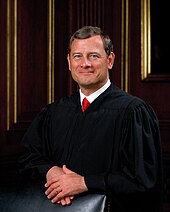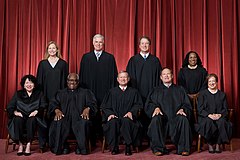
The Supreme Court of the United States (SCOTUS) is the highest court in the federal judiciary of the United States. It has ultimate appellate jurisdiction over all U.S. federal court cases, and over state court cases that turn on questions of U.S. constitutional or federal law. It also has original jurisdiction over a narrow range of cases, specifically "all Cases affecting Ambassadors, other public Ministers and Consuls, and those in which a State shall be Party." The court holds the power of judicial review: the ability to invalidate a statute for violating a provision of the Constitution. It is also able to strike down presidential directives for violating either the Constitution or statutory law. Finally, it may interpret the meaning of federal statutes, and, under the Supremacy Clause of the U.S. Constitution, it may strike down provisions of state constitutions and state statutes for being inconsistent with federal law.
Lemon v. Kurtzman, 403 U.S. 602 (1971), was a case argued before the Supreme Court of the United States. The court ruled in an 8–0 decision that Pennsylvania's Nonpublic Elementary and Secondary Education Act from 1968 was unconstitutional and in an 8–1 decision that Rhode Island's 1969 Salary Supplement Act was unconstitutional, violating the Establishment Clause of the First Amendment. The act allowed the Superintendent of Public Schools to reimburse private schools for the salaries of teachers who taught in these private elementary schools from public textbooks and with public instructional materials.

Stephen Gerald Breyer is an American lawyer and jurist who served as an associate justice of the U.S. Supreme Court from 1994 until his retirement in 2022. He was nominated by President Bill Clinton, and replaced retiring justice Harry Blackmun. Breyer was generally associated with the liberal wing of the Court. He is now the Byrne Professor of Administrative Law and Process at Harvard Law School.

Samuel Anthony Alito Jr. is an American jurist who serves as an associate justice of the Supreme Court of the United States. He was nominated to the high court by President George W. Bush on October 31, 2005, and has served on it since January 31, 2006. After Antonin Scalia, Alito is the second Italian American justice to serve on the U.S. Supreme Court.

John Glover Roberts Jr. is an American jurist who has served as the 17th chief justice of the United States since 2005. He has been described as having a moderate conservative judicial philosophy, though he is primarily an institutionalist. For his willingness to work with the Supreme Court's liberal bloc, Roberts has been regarded as a swing vote on the U.S. Supreme Court.

The Supreme Court of the United States is the only court specifically established by the Constitution of the United States, implemented in 1789; under the Judiciary Act of 1789, the Court was to be composed of six members—though the number of justices has been nine for most of its history, this number is set by Congress, not the Constitution. The court convened for the first time on February 2, 1790.

Neil McGill Gorsuch is an American jurist who serves as an associate justice of the Supreme Court of the United States. He was nominated by President Donald Trump on January 31, 2017, and has served since April 10, 2017.

The Rehnquist Court was the period in the history of the Supreme Court of the United States during which William Rehnquist served as Chief Justice. Rehnquist succeeded Warren Burger as Chief Justice after the latter's retirement, and Rehnquist held this position until his death in 2005, at which point John Roberts was nominated and confirmed as Rehnquist's replacement. The Rehnquist Court is generally considered to be more conservative than the preceding Burger Court, but not as conservative as the succeeding Roberts Court. According to Jeffrey Rosen, Rehnquist combined an amiable nature with great organizational skill, and he "led a Court that put the brakes on some of the excesses of the Earl Warren era while keeping pace with the sentiments of a majority of the country."

The Supreme Court of the United States handed down eight per curiam opinions during its 2006 term, which began October 2, 2006 and concluded September 30, 2007.
Bartlett v. Strickland, 556 U.S. 1 (2009), is a United States Supreme Court case in which a plurality of the Court held that a minority group must constitute a numerical majority of the voting-age population in an area before section 2 of the Voting Rights Act requires the creation of a legislative district to prevent dilution of that group's votes.

The Supreme Court of the United States handed down six per curiam opinions during its 2012 term, which began October 1, 2012 and concluded October 6, 2013.

The Supreme Court of the United States handed down eight per curiam opinions during its 2013 term, which began October 7, 2013 and concluded October 5, 2014.

The Supreme Court of the United States handed down nine per curiam opinions during its 2016 term, which began October 3, 2016 and concluded October 1, 2017.
Nelson v. Colorado, 581 U.S. ___ (2017), is a decision by the Supreme Court of the United States. In a 7-1 decision written by Justice Ruth Bader Ginsburg, the Court held that a state had no right to keep fines and other money based on an invalid conviction. Justice Samuel Alito wrote an opinion concurring in the judgment, Justice Clarence Thomas wrote a dissenting opinion, and Justice Neil Gorsuch did not take part in the consideration or decision of the case.
Janus v. American Federation of State, County, and Municipal Employees, Council 31, No. 16-1466, 585 U.S. ___ (2018), abbreviated Janus v. AFSCME, is a landmark decision of the US Supreme Court on US labor law, concerning the power of labor unions to collect fees from non-union members. Under the Taft–Hartley Act of 1947, which applies to the private sector, union security agreements can be allowed by state law. The Supreme Court ruled that such union fees in the public sector violate the First Amendment right to free speech, overruling the 1977 decision in Abood v. Detroit Board of Education that had previously allowed such fees.
Sessions v. Dimaya, 584 U.S. 148 (2018), was a United States Supreme Court case in which the Court held that 18 U.S.C. § 16(b), a statute defining certain "aggravated felonies" for immigration purposes, is unconstitutionally vague. The Immigration and Nationality Act (INA) classifies some categories of crimes as "aggravated felonies", and immigrants convicted of those crimes, including those legally present in the United States, are almost certain to be deported. Those categories include "crimes of violence", which are defined by the "elements clause" and the "residual clause". The Court struck down the "residual clause", which classified every felony that, "by its nature, involves a substantial risk" of "physical force against the person or property" as an aggravated felony.
June Medical Services, LLC v. Russo, 591 U.S. ___ (2020), was a United States Supreme Court case in which the Court ruled that a Louisiana state law placing hospital-admission requirements on abortion clinics doctors was unconstitutional. The law mirrored a Texas state law that the Court found unconstitutional in 2016 in Whole Woman's Health v. Hellerstedt (WWH).
Bostock v. Clayton County, 590 U.S. 644 (2020), is a landmark United States Supreme Court civil rights decision in which the Court held that Title VII of the Civil Rights Act of 1964 protects employees against discrimination because of sexuality or gender identity.
Sackett v. Environmental Protection Agency, 598 U.S. 651 (2023), also known as Sackett II, was a United States Supreme Court case related to the scope of the Clean Water Act.



















